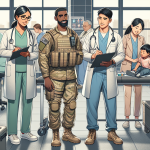Definition
The term “global distribution of materiel” in military operations refers to the worldwide transportation and delivery of military supplies and equipment. It involves the management and coordination of moving these goods from the point of origin to their intended destination. This operation is crucial in supporting a military force’s readiness and operational capabilities.
Key Takeaways
- The term ‘Global distribution of materiel’ pertains to the logistics of moving military equipment, supplies, and personnel around the world. It’s a key aspect of military readiness, ensuring that all necessary resources are available where and when they’re needed.
- The process involves a wide array of activities such as procurement, maintenance, transportation, and disposition of materiel. It’s efficiently managed with advanced logistics and supply chain methodologies to account for variables like geographical challenges, security risks, and time-critical operations.
- Executing global distribution of materiel requires robust planning, strategic partnerships, technological backing, and careful resource management to overcome potential obstacles. It involves multiple military departments and teams working together and often collaborating with civilian logistics and transportation networks.
Importance
The military operations term “global distribution of materiel” is crucial as it refers to the comprehensive process of managing, controlling, and executing the allocation and movement of military resources worldwide.
This system ensures that military troops, irrespective of their location on the globe, are adequately equipped with the necessary supplies they need for their defense missions.
The distribution includes anything ranging from clothing, weaponry, food, to vehicles.
A well-coordinated and effective global distribution of materiel can significantly determine the success of military operations, enhancing their agility, readiness, and capabilities in responding to both domestic and international crises.
Therefore, it plays a pivotal role in promoting the operational efficiency and combat preparedness of the military.
Explanation
The global distribution of materiel refers to the systematic dispersal of military resources that encompass transportation, stationing and logistical support to worldwide operations. The purpose of global distribution is to ensure that wherever armed forces are deployed – be it close to home or halfway across the world – they have safe and timely access to the resources they require to carry out their missions effectively. This not only includes weaponry and vehicles but also individual soldier’s equipment, food supplies, fuel, and medical resources, among others.
Therefore, the core aim of global distribution is to sustain military performance and maintain preparedness in any operational environment, anywhere in the world. In terms of application, efficient and effective global distribution of materiel is a complex and critical component of military operations. Coordinating such a broad range of supply chains across the world demands robust planning, communication, and control mechanisms.
Global distribution is intricately linked to geopolitical dynamics, operational needs, advances in technology, and transport capabilities. Its success influences the operational readiness of troops, the effectiveness of missions, and can significantly impact the outcome of both tactical engagements and broader strategic endeavors. By ensuring that armed forces are well-equipped to engage in combat or peacekeeping actions, global distribution upholds national security and contributes to the fulfillment of international political and military objectives.
Examples of Global distribution of materiel
Operation Enduring Freedom – After the 9/11 attacks, the U.S. military launched Operation Enduring Freedom in Afghanistan. This operation required a vast global distribution of materiel, including weapons, food, uniforms, medical supplies, and other types of equipment. The logistical challenges involved were immense, covering both sea and air routes to transport these goods from the U.S. to the Middle Eastern country.
World War II – The Lend-Lease Program was a significant instance of global distribution of materiel. During World War II, the United States provided critical support to Allied nations via a program called Lend-Lease. This involved the massive distribution of war materials, such as tanks, airplanes, and munitions, to countries like the UK, China, and the Soviet Union. This global distribution was crucial to the success of the Allies in the war.
COVID-19 pandemic – Though not a traditional military operation, the global logistics network of the U.S. Military was employed to combat the COVID-19 pandemic. The U.S Department of Defense coordinated with civilian agencies and international partners to distribute medical supplies and support equipment worldwide. This involved strategic planning to ensure the timely and efficient delivery of masks, ventilators, vaccines and other critical supplies to the areas in need.
“`html
Frequently Asked Questions about Global Distribution of Materiel
What is Global Distribution of Materiel?
The Global Distribution of Materiel refers to the international logistics process of managing and moving military resources from one global location to another. This includes everything from raw materials to finished products.
Why is Global Distribution of Materiel important?
It is crucial for a military organization as it allows for the efficient movement and delivery of necessary supplies and equipment to where they are needed most. This supports the various military operations and tasks worldwide.
What are the common challenges in the Global Distribution of Materiel?
Challenges include logistic complexity due to different international freight and customs rules, ensuring the security of high value or sensitive items, timely delivery to remote or difficult-to-access locations, and the handling and transportation of hazardous materials.
How is the performance of Global Distribution of Materiel evaluated?
Performance is typically evaluated based on several factors which may include effectiveness in cost control, delivery speed, success in meeting logistical requirements, and adherence to safety and regulatory guidelines.
“`
Note: This answer assumes that you’re embedding this code into an existing HTML page which already includes needed “html”, “head”, and “body” tags.
Related Military Operation Terms
- Logistics and Supply Networks
- Inventory Management
- Supply Chain Efficiency
- Military Materiel Distribution
- Strategic Resource Allocation
Sources for More Information
Sure, here are four sources about ‘Global distribution of materiel’ within the military operations context:
- U.S. Department of Defense – The official website of the U.S. Department of Defense gives precise information on the distribution of materiel across the globe.
- Defense Logistics Agency – The DLA is part of the U.S. Department of Defense and charges with the global distribution of military logistics.
- RAND Corporation – The RAND Corporation conducts research and analysis on a broad range of topics, including military logistics.
- The Joint Chiefs of Staff – As part of the Department of Defense, it also provides valuable insights into the global distribution of military resources.
These sources are fairly reliable to understand the concept of Global distribution of materiel.
 Benefits.com Advisors
Benefits.com Advisors
With expertise spanning local, state, and federal benefit programs, our team is dedicated to guiding individuals towards the perfect program tailored to their unique circumstances.
Rise to the top with Peak Benefits!
Join our Peak Benefits Newsletter for the latest news, resources, and offers on all things government benefits.


















